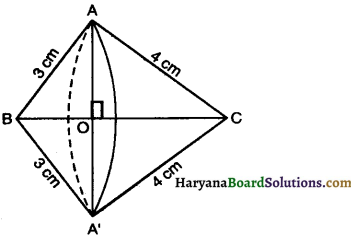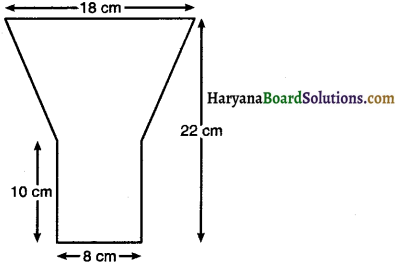Haryana State Board HBSE 10th Class Maths Solutions Chapter 13 Surface Areas and Volumes Ex 13.5 Textbook Exercise Questions and Answers.
Haryana Board 10th Class Maths Solutions Chapter 13 Surface Areas and Volumes Ex 13.5
Question 1.
A copper wire, 3 mm in diameter, is wound about a cylinder whose length is 12 cm and diameter 10 cm, so as to cover the curved surface area of the cylinder. Find the length and masa of the wire, assuming the density of copper to be 8.88 g per cm3.
Solution:
We have,
Diameter of copper wire (d) = 3 mm = \(\frac{3}{10}\) cm
length of the cylinder (h) = 12 cm
To cover the C.S.A. of the cylinder taken number of rounds = \(\frac{h}{d}\)
= \(\frac{\frac{12}{3}}{10}\)
= \(\frac{12 \times 10}{3}\)
= 40
Length of wire used in taking one round = circumference of base of cylinder
= 2πr
= 2 × 3.14 × 5
= 31.4 cm
Total length of wire used in covering the C.S.A. of the cylinder = 31.4 × 40 = 1256 cm
Thus, radius of wire = \(\frac{3}{10 \times 2}=\frac{3}{20}\) cm
length of wire = 1256 cm
∴ volume of wire = πr2h
= \(\frac{22}{7} \times \frac{3}{20} \times \frac{3}{20} \times 1256\)
= \(\frac{22}{7} \times \frac{9}{100} \times 314\)
= \(\frac{62172}{700}\)
= 88.817 cm3
Mass of the wire = Volume of the wire × Density
= 88.817 × 8.88
= 788.69 gram
= 788 gram (approx)
Hence, length of wire = 1256 cm
and mass of wire = 788 gram (approx).
![]()
Question 2.
A right triangle, whose sides are 3 cm and 4 cm (other than hypotenuse) is made to revolve about its hypotenuse. Find the volume and surface area of the double cone so formed. (Choose value of p as found appropriate.)
Solution:
We have,
Sides of right triangle are 3 cm and 4 cm.
Let ∆ABC be right triangle right angled at A.
Length of side BC = \(\sqrt{3^2+4^2}\)
= \(\sqrt{9+16}=\sqrt{25}\) = 5 cm

By revolving ∆ABC around its hypotenuse BC, the double cone solid is formed.
This solid consists of two cones (BAA’) and (CAA’) and AO or A’O is the radius of the common base of the double cone
let BO = x and AO = y.
In right ∆AOB we get AB2 = BO2 + AO2 (By Pythagoras theorem)
⇒ 32 = at2 + y2
⇒ x2 + y2 = 9 ………………(1)
and in right ∆AOC,
AC2 = AO2 + OC2
⇒ 42 = y2 + (5 – x)2
⇒ 16 = y2 + 25 + x2 – 10x
⇒ 16 = 9 + 25 – 10x
[∵ From (1) x2 + y2 = 9]
⇒ 16 = 34 – 1ox = 18
⇒ 10x = 34 – 16 = 18
⇒ x = \(\frac{18}{10}\) = 1.8 cm
Putting the value of x in (1), we get
(1.8)2 + y2 = 9
⇒ 3.24 + y2 = 9
⇒ y2 = 9 – 3.24 = 5.76
⇒ y = √5.76 = 2.4 cm
AO = 2.4 cm,
BO = 1.8 cm and
OC = 5 – 1.8 = 3.2 cm
Volume of the double cone = Sum of the volume of the two cones
= \(\frac{1}{3}\) π × AO2 × BO + \(\frac{1}{3}\) π × AO2 × OC
= \(\frac{1}{3}\) π × (2.4)2 × 1.8 + \(\frac{1}{3}\) π × (2.4)2 × 3.2
= \(\frac{1}{3}\) π × (2.4)2 (1.8 + 3.2)
= 3.14 × 1.92 × 5
= 30.144 cm3
Surface area of the double cone = C.S.A of cone (BAA’) + C.S.A. of cone (CAA’)
= π × AO × AB + π × AO × AC
= π × AO (AB + AC)
= 3.14 × 2.4 (3 + 4)
= 3.14 × 2.4 × 7 = 52.752 cm2.
Hence, volume and surface area of the double cones are 30.14 cm3 and 52.75 cm2 respectively.
![]()
Question 3.
A cistern, internally measuring 150 cm × 120 cm × 110 cm, has 129600 cm3 of water in it. Porous bricks are placed in the water until the cistern is full to the brim. Each brick absorbs one- seventeenth of its own volume of water. How many bricks can be put in without overflowing the water, each brick being 22.5 cm × 7.5 cm × 6.5 cm ?
Solution:
We have,
Volume of cistern = 150 × 120 × 110 = 1980000 cm3
Volume of water in cistern = 129600 cm3
Volume of 1 brick = 22.5 × 7.5 × 6.5 = 1096.875 cm3
Volume of water absorbed by one brick = \(\frac{1}{17}\) × 1096.875 cm3
Let number of brick be x which can be put in the cistern.
Volume of water absrobed by x bricks = \(\frac{x}{17}\) × 1096.875 cm3
Volume of water lift in the cistern = (129600 – \(\frac{x}{17}\) × 1096875) cm3
Volume of the cistern= Volume of the bricks + Volume of water left in the cistern
⇒ 1980000 = x × 1096.875 + 129600 – \(\frac{x}{17}\) × 1096.875
⇒ 1980000 – 129600 = \(\frac{17550x}{17}\)
⇒ 1850400 = \(\frac{17550x}{17}\)
⇒ x = \(\frac{1850400 \times 17}{17550}\)
⇒ x = \(\frac{31456800}{17550}\)
⇒ x = 1792.41
⇒ x = 1792
Hence, number of bricks = 1792.
Question 4.
In one fortnight of a given month, there was a rain fall of 10 cm iñ a river vafley. If the area of the valley is 97280 km2. Show that the total rain fall was approximately equivalent to the addition to the normal water of three rivers each 1072 km long, 75 m wide and 3 in deep.
Solution:
We have,
dimensions of each river are length = 1072 kin, width = 75 m, depth = 3 m
Volume of water of 3 rivers = 3 × 1072 × \(\frac{75}{1000} \times \frac{3}{1000}\) km3.
= 0.7236 km3.
Height of rainfall = 10 cm
= \(\frac{10}{100000}\) = \(\frac{1}{10000}\)
Area of valley = 97280 km
Volume of water of rain fall = 97280 × \(\frac{1}{10000}\)
= 97280 km3
Volume of water of rain fall is not equal to volume of water of three rivers.
![]()
Question 5.
An oil funnel made of tin sheet consists of a 10 cm long cylindrical portion attached to a frustum of a cone. If the total height is 22 cm, diameter of the cylindrical portion is 8 cm and diameter of the top of funnel is 18 cm. Find the area of the tin sheet required to make the funnel (see in figure).

Solution:
We have,
Radii of upper end and lower end of frustum of a cone are
r1 = \(\frac{18}{2}\) = 9 cm
r2 = \(\frac{8}{2}\) = 4 cm
Height of the frustum of a cone (h1) = 22 – 10 = 12 cm
Height of the cylindrical portion (h2) = 10 cm
Slant height of the frustum of cone = \(\sqrt{h^2+\left(r_1-r_2\right)^2}\)
= \(\sqrt{12^2+(9-4)^2}\)
= \(\sqrt{144+25}\)
= \(\sqrt{169}\) = 13 cm
Area of tin sheet required = C.S.A of frustum of a cone + C.S.A. of cylindrical portion.
= π l(r1 + r2) + 2πr2h2
= π [l(r1 + r2) + 2 r2h2]
= π (13 (9 + 4) + 2 × 4 × 10]
= π [13 × 13 + 80]
= π (169 + 80)
= 249 π
= \(\frac{249 \times 22}{7}\)
= 782\(\frac{4}{7}\) cm2
Hence, required area of tin sheet = 782\(\frac{4}{7}\) cm2